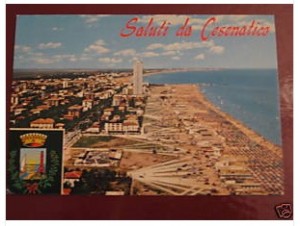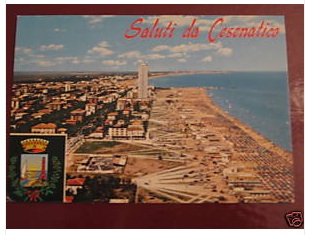Massimo Giovanardi
[for the English version see below]
Su In Loco, il mio blog dedicato al branding e territoriale al place management, mi capita spesso di occuparmi di turismo. Tante sono le destinazioni turistiche marittime italiane ora nel loro placido letargo. Nel “regime stagionale” che governa le zone costiere, infatti, estate e inverno sono come i due movimenti di un vecchio orologio a pendolo: uno di seguito all’altro, ma separati. Oggi vorrei fare qualche riflessione sulla natura delle destinazioni turistiche come luoghi che vengono condivisi, immaginati e creati sia dai residenti che dai turisti. Questo post non riguarda dunque in maniera specifica il brand e il branding, ma ci tornerà d’aiuto per capire il fascino e la complessità dei luoghi del turismo.

Qualche giorno fa ho avuto un’interessante conversazione con un turista tedesco nell’hotel che un mio amico gestisce a Cesenatico, mio paese natale. Matt è nato in Germania, poi si è trasferito in varie nazioni del mondo come il Regno Unito e il Canada. In seguito è tornato in Germania con la moglie, mentre la figlia ha continuato a vivere e studiare in Canada. Da quest’anno in poi, infine, anche la figlia li raggiungerà in territorio teutonico per vivere con loro. “Questo hotel è come una casa per me – spiega Matt. Mi sono spostato un sacco di volte nella mia vita, ho cambiato case e abitudini, ma ogni estate della mia vita da quando sono bambino vengo qui in vacanza, prima coi miei genitori e ora con la mia famiglia. Questo luogo rappresenta la stabilità per noi. La prima volta che ho messo piede qui il figlio del proprietario non era ancora nato e ricordo com’era l’hotel prima che lo mettessero a nuovo. Voi ragazzi siete troppo giovani per ricordarlo”.
Non avevo mai sentito prima d’ora qualcuno parlare della mia piccola città natale in questa maniera. Questo devoto turista possiede dei ricordi su di essa che nemmeno io ho, nonostante qui io sia nato e vi abbia trascorso gran parte della mia vita. L’uomo con cui ho parlato possiede dunque una connessione così intima con Cesenatico da rendere come ininfluenti le migliaia di miglia che separano me e la sua città dal suo paese tedesco. Cesenatico è “casa” sia per me che per lui: entrambi riempiamo questo luogo di ricordi, significati, emozioni, relazioni.
Le narrative giocano un ruolo importante nel place branding, poiché fare place branding significa raccontare una storia su di un luogo, o, meglio, invitare le persone a raccontare una storia su quel luogo, diventandone in maniera volontaria ambasciatori. La toccante storia raccontata dall’ambasciatore Matt sulla sua famiglia e il loro rituale turistico mi ha impressionato. Essa mostra che un turista può essere un ambasciatore della mia città più convincente e persuasivo di me. Non avrei mai trovato parole migliori delle sue per descrivere le profonde radici che gli uomini sviluppano in relazione ai territori, in questo caso luoghi turistici. Esiste dunque una formula per fare innamorare a tal punto un turista di una destinazione? Se c’è, non è di certo così semplice.
– – – – – – –
Tthe many Italian seaside tourist destinations are nowin a status of “hibernation”. In the “seasonal regime” governing the coastal regions, that is to say, summer and winter are like the two movements of a grandfather clock: they are contiguous but separated. Today I would like to make some reflections on the nature of tourist destinations as places which are shared, imagined and created by both tourists and locals. This entry is thus not specifically about brands and branding, but it will help us to understand how complex and fascinating tourist places are.
A few days ago I had an inspiring conversation with a German tourist in a hotel owned by a friend in my birth-town (Cesenatico, on the Romagna Coastal Region). Matt was born in Germany, then he moved through different countries across the world, such as the UK and Canada. Finally he got back to Germany with his wife, while their daughter remained in Canada to live and study. From next autumn on, the daughter too will go back to Germany. “This hotel is home for me – explains Matt. I have travelled a lot in my life, I have changed houses and habits, but every summer of my life since I was a child I have been coming here, first with my parents and then with my own family. This place represents stability for us. The first time I came here the owner’s son hadn’t been born yet and I remember how the hotel looked like before the renovation! You guys were too young to remember this”.
I had never heard someone talking about my birth-place like this before. This devoted tourist has memories of my town that I have not, even though I was born here and spent most of my life here. I felt that the German man had such an intimate connection with my birth-place that it makes no difference if he lived thousands of miles from here. This is really “home” for both of us: we both load it with memories, meanings, emotions, relationships.
Narratives play an important role in place branding, since branding a place means telling a story about it or – better still – inviting people to tell a story about it, thus voluntarily becoming ambassadors of that place. The touching story told by the “ambassador” Matt impressed me. It showed that a tourist can be a more convincing and persuading ambassador of my town than me. I would have never found better words to describe the deep roots that humans develop with places and, like in this case, tourist places. Is there a formula to make tourists fall in love with a destination? If there’s one, it’s certainly not so easy.

